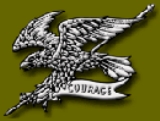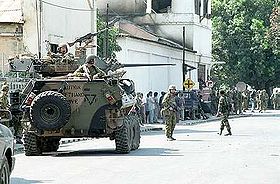
Australian 2nd Cavalry Regiment
Encyclopedia

Cavalry
Cavalry or horsemen were soldiers or warriors who fought mounted on horseback. Cavalry were historically the third oldest and the most mobile of the combat arms...
regiment
Regiment
A regiment is a major tactical military unit, composed of variable numbers of batteries, squadrons or battalions, commanded by a colonel or lieutenant colonel...
of the Australian Army
Australian Army
The Australian Army is Australia's military land force. It is part of the Australian Defence Force along with the Royal Australian Navy and the Royal Australian Air Force. While the Chief of Defence commands the Australian Defence Force , the Army is commanded by the Chief of Army...
. The second most senior regiment in the Royal Australian Armoured Corps, 2 CAV serves in an armoured reconnaissance
Armoured reconnaissance
Armoured reconnaissance is terrestrial reconnaissance by soldiers in reconnaissance vehicles. The mission of armoured reconnaissance is to gather intelligence about the enemy.-Australia:...
role and is attached to the 1st Brigade, based in Darwin
Darwin, Northern Territory
Darwin is the capital city of the Northern Territory, Australia. Situated on the Timor Sea, Darwin has a population of 127,500, making it by far the largest and most populated city in the sparsely populated Northern Territory, but the least populous of all Australia's capital cities...
in the Northern Territory
Northern Territory
The Northern Territory is a federal territory of Australia, occupying much of the centre of the mainland continent, as well as the central northern regions...
.
History
The regiment was formed in 1965 as 1st Cavalry Regiment through the regimentation of regular squadrons in Citizens Military ForceAustralian Army Reserve
The Australian Army Reserve is a collective name given to the reserve units of the Australian Army. Since the Federation of Australia in 1901, the reserve military force has been known by many names, including the Citizens Forces, the Citizen Military Forces, the Militia and, unofficially, the...
regiments:
- A Squadron – A Squadron, 4th/19th Prince of Wales's Light Horse4th/19th Prince of Wales's Light HorseThe 4th/19th Prince of Wales's Light Horse is a cavalry regiment of the Australian Army. The regiment in its current composition was formed in 1948 when the Citizens Military Force was re-raised after the completion of the demoblisation process following the end of the Second World War and it was...
- B Squadron – A Squadron, 2nd/14th Queensland Mounted Infantry2nd/14th Light Horse RegimentThe 2nd/14th Light Horse Regiment is a regiment of the Australian Army and forms part of the Royal Australian Armoured Corps. The regiment was formed in 1952 though sentimentally traces its lineage to 1860...
.
These two squadrons initially had no Regimental Headquarters or HQ Squadron. However, with reorganisation of the RAAC came both an RHQ and a new name. RHQ and HQ Sqn formed at Gallipoli Lines, Holsworthy
Holsworthy
Holsworthy is the name of several places and other things associated with those places:*Holsworthy, Devon, England**Holsworthy A.F.C., a football club in Holsworthy, Devon**Holsworthy Beacon*Holsworthy Hamlets, another parish, also in Devon...
on 20 November 1970. In order to avoid confusion, it was decided that the armoured regiments of the regular army would be numbered sequentially; 1st Armoured Regiment was the most senior, so 1st Cavalry was renamed 2nd Cavalry Regiment.
When first formed, the regiment consisted of a reconnaissance squadron and an armoured personnel carrier squadron. This continued until 1976, when the Royal Australian Regiment
Royal Australian Regiment
The Royal Australian Regiment is the parent regiment for regular infantry battalions of the Australian Army and is the senior infantry regiment of the Royal Australian Infantry Corps...
took on a mechanised role, leaving 2nd Cavalry Regiment to concentrate on the reconnaissance role. By 1996, 'C' Squadron was raised. All three squadrons were equipped with the M113
M113 armored personnel carrier
The M113 is a fully tracked armored personnel carrier that has formed the backbone of the United States Army's mechanized infantry units from the time of its first fielding in Vietnam in April 1962. The M113 was the most widely used armored vehicle of the U.S...
vehicle in the reconnaissance role until the mid 1990s, with the regiment being re-equipped with the Australian Light Armoured Vehicle (ASLAV)
ASLAV
The Australian Service Light Armoured Vehicle , is an Australian version of the Light Armoured Vehicle designed and manufactured by General Dynamics Land Systems Canada for the U.S. Marines. The initial design was the MOWAG Piranha 8x8, however the vehicle was re-designed to meet North American...
between 1995 and 1997. Among the specialised equipment used in reconnaissance by the regiment is the Australian Man-portable Surveillance and Target Acquisition Radar (AMSTAR)
MSTAR
Man-portable Surveillance and Target Acquisition Radar is a light weight all-weather battlefield radar Doppler radar operating in the J band. It is usually used by Artillery Observers to acquire and engage targets in bad visibility or at night...
system which is able to detect and recognise moving targets including personnel, vehicles, watercraft and low flying helicopters. AMSTAR has a target detection and classification capability at ranges up to 35,000 metres. Although the system can be moved by a few personnel it is commonly mounted on the ASLAV-S
ASLAV
The Australian Service Light Armoured Vehicle , is an Australian version of the Light Armoured Vehicle designed and manufactured by General Dynamics Land Systems Canada for the U.S. Marines. The initial design was the MOWAG Piranha 8x8, however the vehicle was re-designed to meet North American...
s. A ruggedised laptop is used for data processing in conjunction with an aural indicator.
Since being re-equipped with the ASLAV
ASLAV
The Australian Service Light Armoured Vehicle , is an Australian version of the Light Armoured Vehicle designed and manufactured by General Dynamics Land Systems Canada for the U.S. Marines. The initial design was the MOWAG Piranha 8x8, however the vehicle was re-designed to meet North American...
the 2nd Cavalry Regiment has played a key role in Australian military operations. In 1999, 'C' Squadron deployed to East Timor
East Timor
The Democratic Republic of Timor-Leste, commonly known as East Timor , is a state in Southeast Asia. It comprises the eastern half of the island of Timor, the nearby islands of Atauro and Jaco, and Oecusse, an exclave on the northwestern side of the island, within Indonesian West Timor...
as part of the initial Australian contribution to INTERFET
INTERFET
The International Force for East Timor was a multinational peacekeeping taskforce, mandated by the United Nations to address the humanitarian and security crisis which took place in East Timor from 1999–2000 until the arrival of United Nations peacekeepers...
, with the ASLAVs providing the Australian force with the majority of its mobility and armoured support during the early days of the intervention. Detachments from the regiment supported all subsequent Australian troop deployments to East Timor.
More recently, 2nd Cavalry Regiment has deployed its ASLAVs to Iraq
Iraq
Iraq ; officially the Republic of Iraq is a country in Western Asia spanning most of the northwestern end of the Zagros mountain range, the eastern part of the Syrian Desert and the northern part of the Arabian Desert....
in the aftermath of the 2003 invasion. The regiment's initial role was to provide armoured transport for Australian diplomats and military personnel based in Baghdad
Baghdad
Baghdad is the capital of Iraq, as well as the coterminous Baghdad Governorate. The population of Baghdad in 2011 is approximately 7,216,040...
and northern Iraq. The regiment has also formed a key element of the Al Muthanna Task Group
Al Muthanna Task Group
The Al Muthanna Task Group was a battlegroup that formed Australia's main ground force contribution to the Multinational force in Iraq. The AMTG was established in April 2005 and ceased to exist in July 2006 when the Australian force was relocated to Dhi Qar Governorate as Overwatch Battle Group...
, with the Regimental Headquarters commanding the initial rotation and a squadron from the Regiment forming part of the first two rotations of Task Group elements.
Current composition
Currently the regiment is made up of:- Regimental Headquarters (RHQ)
- Three Sabre Squadrons (A, B and C Squadrons)
- Support Squadron.
Each of the three Sabre Squadrons is equipped with 26 ASLAVs, while the Support Squadron provides the combat service support to the regiment.
Regimental Badge
The regiment's badge is an Australian Wedge-tailed EagleWedge-tailed Eagle
The Wedge-tailed Eagle , sometimes known as the Eaglehawk in its native range, is the largest bird of prey in Australia, but it is also found in southern New Guinea. It has long, fairly broad wings, fully feathered legs, and an unmistakable wedge-shaped tail...
swooping, with a lance
Lance
A Lance is a pole weapon or spear designed to be used by a mounted warrior. The lance is longer, stout and heavier than an infantry spear, and unsuited for throwing, or for rapid thrusting. Lances did not have tips designed to intentionally break off or bend, unlike many throwing weapons of the...
and a banner bearing the word "courage" in its talons. This came about soon after the regiment's formation, when a competition was held to design an appropriate badge. A bird-of-prey was decided upon due to the regiment's reconnaissance role. The Wedge Tailed Eagle was chosen due to its "keenness of sight and ability to roam over large distances". The badge was awarded in 1967. Within the regiment the badge is known as "the chook on a stick", chook being colloquial Australian for a chicken.
Guidon
The regiment's first Guidon was presented in 1972, when 'A' Sqn, 3 Cav Regt was transferred to 2 Cav Regt. This was lost when the Officers Mess was destroyed by fire in 1990. A new Guidon was presented the same year.Mascot
The regiment's mascot is a Wedge-tailed Eagle named "Courage". Since its formation, there have been two:- Courage I: Trooper Courage was presented to the regiment as a six-week old eaglet in 1967, and participated in virtually every regimental ceremony from 1969 onwards, including taking part in the House Guard for HM The Queen in 1974. Courage rose to the rank of SergeantSergeantSergeant is a rank used in some form by most militaries, police forces, and other uniformed organizations around the world. Its origins are the Latin serviens, "one who serves", through the French term Sergent....
before she died in 1987.
- Courage II: A new mascot, again named Courage, was presented to the regiment in 1987. His first major ceremonial occasion was as part of the guard for HRH The Prince of WalesCharles, Prince of WalesPrince Charles, Prince of Wales is the heir apparent and eldest son of Queen Elizabeth II and Prince Philip, Duke of Edinburgh. Since 1958 his major title has been His Royal Highness The Prince of Wales. In Scotland he is additionally known as The Duke of Rothesay...
during his visit to Australia in 1988 for the bicentennial celebrations. In 1997, while on flight training with his handlers, Corporal Courage refused to cooperate and flew away, not being found for two days following an extensive search. He was charged with being AWOL and reduced to the rank of Trooper. He was promoted back to Corporal in 1998.
Battle honours
The 2nd Cavalry Regiment holds the following battle honourBattle honour
A battle honour is an award of a right by a government or sovereign to a military unit to emblazon the name of a battle or operation on its flags , uniforms or other accessories where ornamentation is possible....
s, which it inherited from the 2/6th Cavalry (Commando) Regiment:
- North Africa 1940–41, Bardia 1941, Capture of Tobruk, Cerna Giaabub, Syria 1941, Meejayun, Adlum, Sidon, Darmour, South West Pacific 1944–45, Liberation of Australian New Guinea, Abau-Malin, Anub River, Maprik, Wewak, Wirui Mission.

